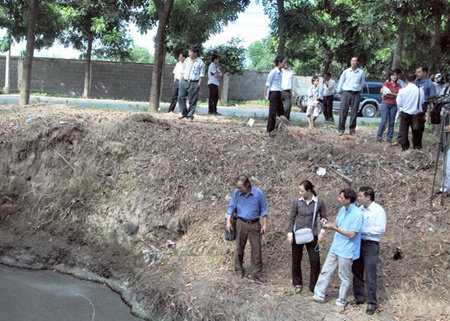A representative from PanNature suggested clearly defining the non-profit status of science and technology organizations to facilitate research, technology transfer, and application. This clarity would also enhance international collaboration and attract funding.

Nation pays heavy price for industrial gains
The excessive number of industrial parks and export processing zones have caused serious environmental pollution in the country, experts said at a seminar held in HCM City last Friday.
Dr Vo Thanh Thu, member of the Viet Nam Chamber of Commerce and Industry’s International Trade Policy Advisory Committee, said that rapid industrialisation in the past 20 years had led to a boom in IPs and export processing zones.
 People from authorised agencies inspect the Ba Bo Canal, which receives wastewater discharged from HCM City’s Dong An Industrial Park. Industrial parks and export processing zones have caused serious environmental pollution in the country. — VNA/VNS Photo Phuong Vy.
People from authorised agencies inspect the Ba Bo Canal, which receives wastewater discharged from HCM City’s Dong An Industrial Park. Industrial parks and export processing zones have caused serious environmental pollution in the country. — VNA/VNS Photo Phuong Vy.
As of last year, the country had 289 IPs, EPZs and hi-tech parks, and 878 industrial clusters.
Thu said the development of IPs and EPZs had contributed to the country’s economic development but those without master zoning plans had low occupancy rates and caused pollution.
“Provinces and cities have raced to set up IPs,” she said, adding that Ha Noi, the country’s administrative centre, was now the largest industrial one, with 19 IPs and EPZs and 40 small IPs and industrial clusters.
However, as of today, only eight out of the 19 IPs have been put into operation.
“In the Cuu Long (Mekong) Delta, 74 IPs are idle, representing a total area of 14,394ha, accounting for 60.2 per cent of the region’s total IP area,” she said.
In addition, up to half of IPs and EPZs have not built waste treatment systems.
Many companies have built such systems but have not used them.
Instead, they directly discharge waste water into the environment, causing serious pollution in local areas and affecting the lives of local residents.
In the past, most localities neglected the issue of environmental protection, as many projects in IPs and EPZs are labour-intensive. Few companies have high-tech equipment.
Workshop attendees also pointed out that laws on IP development contained many loopholes and unreasonable regulations, while penalties were not strong enough.
There is also an overlap in environmental management at IPs, causing difficulties for agencies, said Cao Tien Si, deputy head of the Dong Nai Province Industrial Parks Authority.
Many workshop attendees said that more hi-tech “green” projects were needed at IPs.
They also suggested that the Government and localities review IP zoning plans based on local economic planning, regional development, land use, urban infrastructure and local advantages.
They suggested that agencies work together to improve the monitoring of environmental protection regulations.
The seminar was organised by PanNature (People and Nature Reconciliation), a Vietnamese non-profit organisation established by a group of Vietnamese environmental professionals, in collaboration with other organisations.
By 2015, half of the industrial complexes in Ha Noi will be equipped with collective waste water processing systems, the Ministry of Industry and Trade has said.
Under the VND145 billion (nearly US$7 million) project, which was approved by the city’s People’s Council in the beginning of this month, the systems will be set up in 16 industrial complexes across 14 districts such as Gia Lam, Hoai Duc, Ha Dong, Dong Anh, Thanh Oai, Ninh Hiep, and Thuong Tin during 2014-15.
Of this amount, the Thanh Oai industrial complex in the suburban district of Thanh Oai and the Ninh Hiep industrial complex of the Gia Lam District will receive the highest investment of approximately VND14 billion ($660,000) each, according to Pham Dinh Duong, vice head of the Industrial Complexes Management Board under the Ministry of Industry and Trade.
“Between 40-45 per cent of the project’s total cost will be funded by the State budget while the rest will be paid for by the complex’s investors,” said Duong.
The State budget is to cover works such as waste water collection, construction of waste water reservoirs, operating house of the waste water treatment station and a fence to protect it as well, he added.
Meanwhile, industrial complex investors will cover expenses for installing the equipment, technology and materials to operate the waste water processing systems in compliance with the Ministry of Natural Resources and Environment’s standards.
Ha Noi will conduct measures in order to effectively reduce the industrial pollution in the city by 2015, such as co-operation with relevant departments to increase awareness among the people about the issue as well as involve them further in environment protection.
The project is scheduled to start in the beginning of next month and will hopefully tackle the pollution occurring for years at the industrial complexes, according to Duong.
“After the processing systems are put in place at the industrial complexes, each enterprise is expected to pay VND4,000-8,000 ($0.2-0.4) for every cubic metre of treated waste water,” Duong said.
According to Ha Noi’s statistical data, up to 107 industrial complexes have been built in the city on a total area of 3,200ha. Nevertheless, only seven of them were equipped with collective waste water treatment systems.



